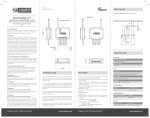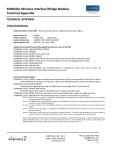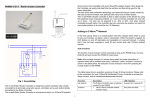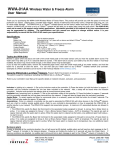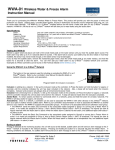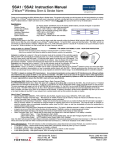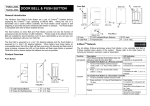Download HAC01 IN-WALL REMOTE MODULE
Transcript
Exclusion Association HAC01 IN-WALL REMOTE MODULE TM This in-wall remote module is a transceiver which is a Z-Wave enabled device and TM is fully compatible with any Z-Wave enabled network. Mini size design let the module can easily put into the wall box and still have enough space to install the traditional wall switch. There are many application for the module , one application is connect the 2 wire of manual switch input to most of the wall switch sell in the market , while the connected wall switch been switched ON or OFF , the module will send the correspond signal to the associated devices like Z-Wave switch module HAN01 or any Z-Wave ON/OFF or dimmer module Another application is connect this module to any traditional wire sensor which has NC/NO manual switch input output, and this will easily convert those wire sensors into wireless Z-wave sensors. With the external antenna let this module have excellent communicate RF range, and this will let the module not only send signal to the associated device by itself easily but also act as a good routing node in the z-wave mesh network. Reset Auto Inclusion The function of auto inclusion will be executed as long as the Module does not have node ID when the first power is applied. 。 After node ID has been linked, auto inclusion will run automatically after the execution of exclusion/reset is successful. Note: Auto inclusion lasts for 4 minute or until the execution of inclusion is completed during which the node information of explorer frame will be emitted once every 5 seconds. Unlike “inclusion” function as shown in the table below, the execution of auto inclusion is free from pressing the link button on the Module. Adding to Z-WaveTM Network The table below lists an operation summary of basic Z-Wave functions. Please refer TM to the instructions for your Z-Wave Certificated Primary Controller to access the setup function, and to include/exclude/associate devices. In the front casing, there is a link button with LED indicator which is used to carry out inclusion, exclusion, reset or association. Function No node ID LED indicator Inclusion Link button Front View Side View Exclusion When first power is applied, the LED flashes on and off alternately and repeatedly at 2-second intervals. It implies that it has not been assigned a node ID and cannot work with Z-Wave enabled devices. Please get familiar with the terms below before starting the operations. Function Inclusion Delete a Z-Wave enabled device from the connected network. After inclusion, you have to define the relationship between devices. Through association, device can be assigned as master or slave, and specify which slave is going to be controlled by which master. Restore the device to factory default. Description After power is applied, if the module does not record a node ID provided by controller. 1. Have Z-Wave remote module entered inclusion mode. 2. Pressing link button three times within 1.5 seconds will enter inclusion mode. 1. Have Z-Wave remote module entered exclusion mode. 2. Pressing link button three times within 1.5 seconds will enter exclusion mode. Node ID has been excluded successfully. Description Add a Z-Wave enabled device to the existed Z-Wave network. 1 LED Indication 2-second on, 2-second off When press on the link button one time, LED blinks for 0.5 sec. and then off When press on the link button one time, LED blinks for 0.5 sec. and then off 2-second on, 2-second off Reset 1. Pressing link button three times within 1.5 seconds . 2. Within 1 second, press link button and hold on until LED is off. 3. Home ID and node ID will be cleared and reset to factory default. Have Z-Wave remote module entered association mode first. Association Pressing link button three times within 1.5 seconds will enter association mode 2. Z-Wave’s Configuration When press on the link button one time, LED blinks for 0.5 sec. and then off 2-1. Basic Set Level The Basic Set Command is sent with value to have the receiving device recognize the value for controlled level, for example, if the Basic Set Command sent to dimmer with value, the dimmer would activate the luminance according to the value, 0 : Off 1 – 99 : On (Binary Switch Device) Dim Level (Multilevel Switch Device) 2-second on, 2-second off When press on the link button one time, LED blinks for 0.5 sec. and then off Configuration Command Function LED Indication Basic Set Level To distinguish what mode the Module is in, view from the LED for identification. State Type Normal No node ID Parameter Number 1 Size Range Default 1 0 ~ 99 99 2-2. Amount Of Delay (seconds) This is applied to determine the delay time setting to send the Basic Set Off command when the manual switch input at NO (open). Example : 0 : immediately Off 1 – 127 : delay 1 ~ 127 second to Off LED Indication Under normal operation with node ID, when manual switch input from open (NO) to short(NC) or from short(NC) to open(NO), the LED would blink for 0.5 second and then go off. Under normal operation but without allocated node ID, the LED flashes on and off alternately at 2-second intervals. Function Programming Amount of delay 1. Z-Wave’s Grouping Feature (Association Command Class Ver 1) Configuration command Parameter Size Number 2 1 Range Default 0 ~ 127 1 3. Supported Command Classes In Brief : The remote module supports association with maximum 5 node for Grouping 1. Grouping 1 supports BASIC_SET When the manual switch input is from NC to NO or from NO to NC, HAC01 would send Basic Set Command to the nodes in Grouping 1 to On or Off the controlled device. COMMAND_CLASS_SWITCH_BINARY COMMAND_CLASS_BASIC COMMAND_CLASS_CONFIGURATION COMMAND_CLASS_MANUFACTURER_SPECIFIC COMMAND_CLASS_VERSION COMMAND_CLASS_ASSOCIATION_V1 Basic Set Command : Manual switch Command Class Basic, Basic Set, Value = 0xFF(255) input at NC Manual switch Command Class Basic, Basic Set, Value = 0x00(0) input at NO Choosing a Suitable Location 1. Do not locate the Module facing direct sunlight, humid or dusty place. 2 2. AC input : AC220~240V/50Hz Europe Australia AC100~120V/60Hz US 3. The suitable ambient temperature for the Module is 0 C~40 C. 4. Do not locate the Module where exists combustible substances or any source of heat, e.g. fires, radiators, boiler etc. 5. After putting it into use, the body of Module will become a little bit hot of which phenomenon is normal. ° ° 2. The Module break down The Module LED Check if the load illuminating, but cannot connected to the Module control the ON/OFF has its own ON/OFF Switch of the load attached switch The Module LED 1. Not carry out illuminating, but the association Detector cannot control 2. Same frequency the Module interference Installation Note: Please note that it is a must to call for a licensed electrician for installation. send it for repair. Set the ON/OFF switch of the load connected to ON 1. Carry out association 2. Wait for a while to re-try Specification Install this Module into a wall box of which wiring connection is shown hereunder: Power Input AC 100~240 V/50~60Hz AC220~240V/50Hz Europe Australia AC100~120V/60Hz US RF Operation Range Minimum 30 m indoor line of sight Operating Temperature 0°C ~ 40°C Frequency Range 868.42 MHz Europe 908.42MHz US 921.42MHz Australia ** Specifications are subject to change and improvement without notice. AC power input Link button Model number information Manual switch input HAC01 can be installed into the in-wall power box, the power cord have to be connected to the main AC power, the manual switch input cable is wired to normal NO (open) / NC (close) button or switch. When the wiring connection is completed, please follow the previous instruction to operate the Inclusion and Association process to finish HAC01’s connection and network setting with controlled device (ex. HAN01). US 908.42MHz HAC01-1 Europe 868.42MHz HAC01-2 Australia 921.42MHz Warning: Troubleshooting Symptom The Module not working and LED off HAC01-0 Cause of Failure 1. Improper wiring connection Recommendation 1. Check power connections 2. Don’t open up the Module and Do not dispose of electrical appliances as unsorted municipal waste, use separate collection facilities. 3 Contact your local government for information regarding the collection systems available. If electrical appliances are disposed of in landfills or dumps, hazardous substances can leak into the groundwater and get into the food chain, damaging your health and well-being. When replacing old appliances with new once, the retailer is legally obligated to take back your old appliance for disposal at least for free of charge. 4





